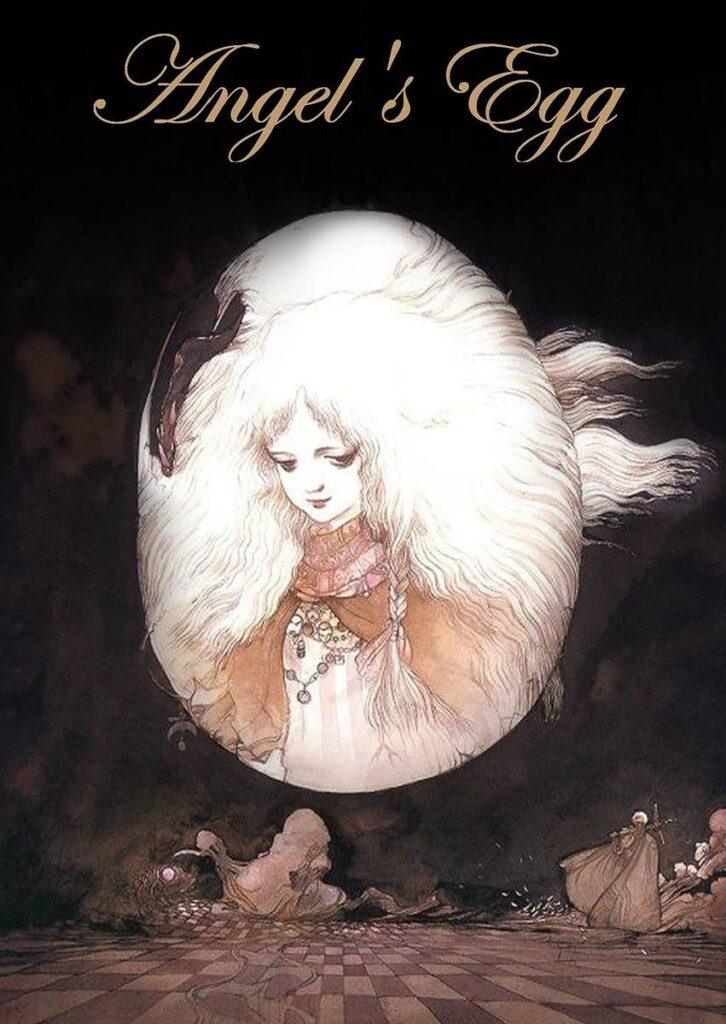Angel’s Egg – A Haunting Dream of Faith, Memory, and Ruin
If ever there were an anime that defied explanation and demanded interpretation, it’s Angel’s Egg. Directed by Mamoru Oshii and illustrated by Yoshitaka Amano, this obscure 1985 masterpiece isn’t so much a story as it is a poetic vision. There is no traditional plot, no loud conflict, and hardly any dialogue. Instead, you’re taken into a drowned, forgotten world where shadows stretch endlessly, and silence says more than words ever could.
Angel’s Egg is a film drenched in symbolism, often interpreted as a meditation on faith, lost innocence, and humanity’s search for meaning. At its center are two unnamed characters — a mysterious young girl who guards a large egg, and a quiet, soldier-like man who seems both protective and destructive. Their interactions unfold slowly in a decaying, dreamlike city that feels suspended outside of time.
The Girl and the Egg – Holding Onto Hope in a Ruined World
The young girl, seemingly alone in a world where the sun never shines, cradles a large egg close to her chest like a sacred object. She hides it, speaks to it, and protects it as though it carries life — or a secret — worth saving. We’re never told what’s inside. That’s part of the mystery. But the way she treats it, with such gentle reverence, suggests it represents something fragile and essential: faith, perhaps, or memory, or hope itself.
She survives by scavenging, walking past gigantic fossilized ruins of unknown creatures and relics of a long-dead civilization. There is no exposition, no narrator to explain the world or its laws. What we’re left with is a visual puzzle — scenes of long-abandoned architecture, water dripping into still pools, and machines that sit motionless, their purpose lost to time.
Her path crosses with the man, who appears with a large cross-shaped object on his back and cryptic words about remembering a world that no longer exists. He questions her, tells parables, and watches her silently. His presence is unsettling. He seems kind, but also dangerous — a reflection of mankind’s dual capacity for creation and destruction.
Symbolism Over Plot – Understanding Without Explaining
Trying to recap Angel’s Egg in a traditional sense misses the point. The film operates on a subconscious level, inviting the viewer to interpret meaning rather than absorb facts. Many have linked its themes to director Mamoru Oshii’s own crisis of faith at the time — particularly the story the man tells of fishermen chasing shadows of giant fish that no longer exist. It’s a fable of pointless devotion, mirroring humanity’s obsession with belief even in the absence of proof.
The egg, in this sense, might represent spiritual faith or the innocence of childhood. The girl’s unwavering care for it contrasts with the man’s more jaded, analytical stance. Their final moments together — when the egg is violently broken — feel both tragic and inevitable. It’s a shattering of illusion, or perhaps a sacrifice that leads to understanding. But even then, nothing is certain. That’s the genius of Angel’s Egg — it refuses to explain itself, trusting its viewers to search for their own answers.
The final images, which show the world transforming again, suggest that even destruction gives birth to new meaning. A massive object resembling an ark emerges from the mist, and the girl’s likeness appears carved into its surface. Whether she has ascended, become part of the world’s mythos, or simply faded into memory is up to each viewer to decide.
A Masterpiece Meant to Be Felt, Not Solved
Angel’s Egg isn’t for everyone. Its slow pacing, lack of dialogue, and opaque narrative alienate many viewers. But for those willing to engage with it emotionally and symbolically, it’s an unforgettable experience. Every frame is meticulously crafted, every sound designed to evoke a sense of loneliness, reverence, and mourning.
Rather than follow a story, the film leads you through feelings — of awe, confusion, sorrow, and quiet transcendence. It’s more like a painting than a screenplay, more like a dream than a tale. And like any great dream, it lingers after waking, unsettling and beautiful in equal measure.



